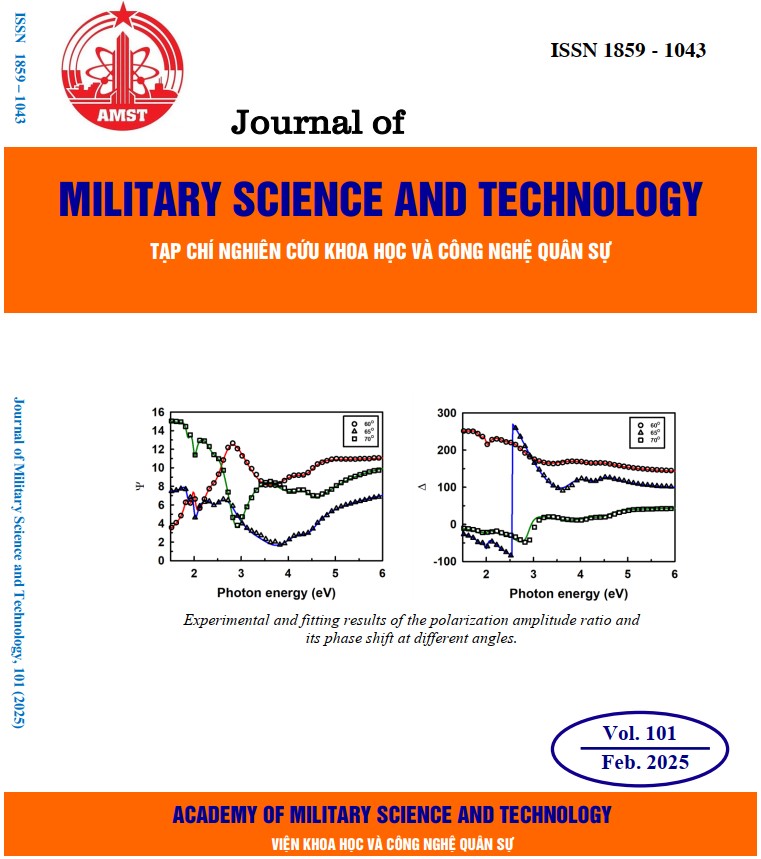Research on the steel corrosion inhibition of green tea leaf extract in a simulated sea water environment
581 viewsDOI:
https://doi.org/10.54939/1859-1043.j.mst.101.2025.88-94Keywords:
Green tea leaf; Polyphenol; Corrosion inhibitor; Electrochemical corrosion; Marine corrosion; CT3 steel.Abstract
In this paper, the effect of polyphenol compounds extracted from green tea leaves to inhibit CT3 steel corrosion in a simulated sea water environment was studied. The corrosion inhibitor is evaluated through some specifications: electrochemical corrossion and salt spray corrosion test by the B117-16 standard. A scanning electron microscope (SEM) and the salt-sprayed steel plate surface observation were used to evaluate the level of corrosion. The CT3 steel soaked in polyphenol solutions with various concentrations and times showed different corrosion resistance in marine conditions. At the polyphenol concentration of 1.5 mg in 1 liter solution, the corrosion rate of CT3 steel is reduced from 0.057 mm/year compared to 0.113 mm/year in the 3.5% NaCl solution without polyphenol, and soaking CT3 steel for 45 minutes in polyphenol : water : ethanol solution (1 g : 90 ml : 910 ml) gives the best resistance to salt spray corrosion.
References
[1]. H. Li et al., “Cutting fluid corrosion inhibitors from inorganic to organic: Progress and applications,” Korean Journal of Chemical Engineering, Vol. 39, No. 5, pp. 1107-1134, (2022). DOI: https://doi.org/10.1007/s11814-021-1057-0
[2]. J. K. Das et al., “Experimental investigation on inhibiting compounds against steel corrosion in concrete admixed with different chloride salts,” Materials and Structures, Vol. 56, No. 14, (2023). DOI: https://doi.org/10.1617/s11527-023-02103-1
[3]. M. P. Casaletto et al., “Inhibitor of cor-ten steel corrosion by “green” extracts of Brassica campestris,” Corrosion science, Vol. 136, pp. 91-105, (2018). DOI: https://doi.org/10.1016/j.corsci.2018.02.059
[4]. I. Pradipta et al., “Natural organic antioxidants from green tea form a protective layer to inhibit corrosion of steel reinforcing bars embedded in mortar,” Construction and Building Materials, Vol. 221, pp. 351-362, (2019). DOI: https://doi.org/10.1016/j.conbuildmat.2019.06.006
[5]. Q. Wang et al., “Evaluation for Fatsia japonica leaves extract (FJLE) as green corrosion inhibitor for carbon steel in simulated concrete pore solutions,” Journal of Building Engineering, Vol. 63, No. 105568, (2023). DOI: https://doi.org/10.1016/j.jobe.2022.105568
[6]. I. M. C. Ienașcu et al., “Some Brassicaceae Extracts as Potential Antioxidants and Green Corrosion Inhibitors,” Materials, Vol. 16, No. 8, (2023). DOI: https://doi.org/10.3390/ma16082967
[7]. R. Shanmugapriya et al., “Electrochemical and Morphological investigations of Elettaria cardamomum pod extract as a green corrosion inhibitor for Mild steel corrosion in 1 N HCl,” Inorganic Chemistry Communications, Vol. 154, No. 110958, (2023). DOI: https://doi.org/10.1016/j.inoche.2023.110958
[8]. D. Pasrija et al., “Techniques for Extraction of Green Tea Polyphenols: A Review,”, Food and Bioprocess Technology, 8(5), pp. 935-950, (2015). DOI: https://doi.org/10.1007/s11947-015-1479-y
[9]. X. S. Trinh, “Ăn mòn và bảo vệ kim loại”, Vietnam National University, Ha Noi Publisher, pp. 149-153, (2006) (in Vietnamese).







